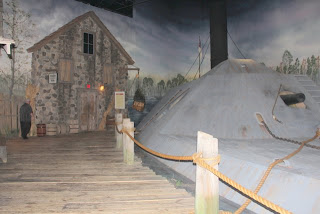We drove last night until it got dark. You always take a chance on lodging the later you go - luckily we found something that was okay out in rural southwest Georgia. The next morning we were up early and heading north with the goal of getting to church on time. We had looked up our options online and made it to Moultrie, Georgia just in time for the meeting. In the early morning, we passed many pecan farms in what looked like harvest time. There were many large trailers filled with the nuts. After church we headed north again, entering Columbus around noon. Columbus is a large military town near Fort Benning (the main infantry training center for the army). Near the main entrance to the Fort is the new National Infantry Museum.
We spent quite a bit of time checking out the many exhibits and the
period items on display. It was very well done and a definite addition
to any trip to this part of the country. Very impressive. Across town is the National Civil War Naval Museum. A very large
civil-war era ship, the CSS Jackson, was found buried in the mud in the
local Chattahoochee River. It was raised and the lower part that
survived the years is on display. It is 180 feet long. Check out the
incredible collection of authentic Civil War naval flags - some bigger
than automobiles. The Museum is filled with a multitude of displays and
is the only museum in America devoted exclusively to the conflict
between the two navies. Just down the road in Alabama is the town of Tuskegee, home of
Tuskegee University. We grabbed a snack in Columbus and headed west.
Tuskegee is a sleepy town that has obviously seen better days. The
University is trying to make a comeback, and if the town is to flourish,
it is pretty clear it will come from the educational angle. We went
there for two reasons, to visit the dual national historic sites - one
for the Tuskegee Airmen and the other for the Tuskegee Institute, the
creation of Booker T. Washington. The latter is centered in the home of
Booker, the "Oaks". When we arrived at the home, to our disappointment,
it was closed. However, we were able to find a park ranger elsewhere on
campus who agreed to give us a tour of the house and tell us about
Booker and his accomplishments. The Airmen site was open and is located
at the municipal airport, which has remained much as it was in the
1940's. The site is quite new and very well done. I was
particularly interested in the training that took place here. It was
described in great detail and was the same as that which Dad Anderton
went through in 1943-44. The fact that Dad also had a connection to
these airmen in Italy made the visit even more meaningful. Great
exhibits! We were making great time with our schedule, so took a few minutes to
drive through Auburn, Alabama and take in the Auburn campus. Nice
football stadium. We found a room outside of Auburn for the night. The next morning, we swung north (still in Alabama) to a battle site
near Alexander City. In a sweeping bend of the Tallapoosa River, General
Andrew Jackson, in 1814, crushed the last resistance of the
Creek Nation, catching them in the peninsula formed by the bend. The
battle essentially led to the ceding of 23 million acres to the United
States from the Creeks (the future Alabama), part of the Trail of Tears,
and the presidency of Andrew Jackson. A beautiful site today, but
hallowed ground and the scene of much bloodshed. Hoping to make it to Chattanooga for the night, we raced into Atlanta,
crossing the Alabama-Georgia border. We negotiated the freeways without
much trouble and enjoyed a tour of the Carter Presidential Center. Not
the best of the presidential libraries, but worth the visit. The site
has a wonderful view of downtown Atlanta and the surrounding landscaping
is exceptional. We drove north in the fading light, finding a room across the Tennessee border in Chattanooga. It was a long day.























No comments:
Post a Comment